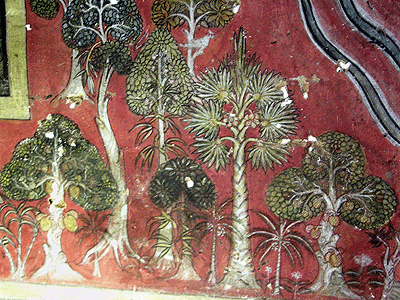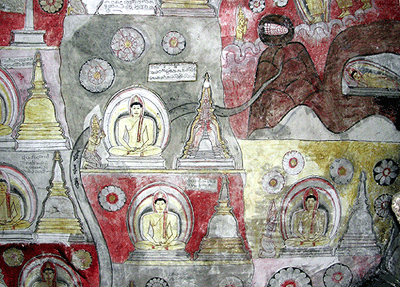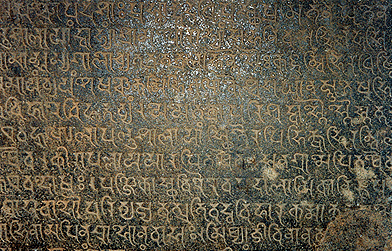SACRED ISLAND
A BUDDHIST PILGRIM'S GUIDE TO SRI LANKA
compiled and edited by Ven. S. Dhammika
INTRODUCTION
Sri Lanka is a small pear-shaped island situated just off the southeastern tip of the Indian sub-continent. It is not a big island being only 270 miles from north to south and 140 miles from east to west at its widest point. The western most point of the island Talaimannar jutting out into the Gulf of Mannar is a mere 20 miles from India. The west and southern coastal plains of Sri Lanka are lush and tropical and this is where the country’s fabled spices come from. Fruits, flowers and grains grow in abundance. The north and east are hot and dry and cultivation is only possible with the help of an extensive system of irrigation. Sri Lanka has been known by a bewildering variety of names throughout its history. Its earliest name, Tambapanni, first appears in one of King Asoka’s inscriptions and is the origin of the name the Greeks knew the island by, Taprobane. The name means ‘Copper-colored Palms’. According to ancient legend when the first immigrants arrived in the island they threw themselves on the shore and the rust-colored earth stained their hands. The Sinhalese have long called their home Lankadipa (Lanka Island) or just Lanka. In the Sanskrit literature of India it was usually known as Ratnadipa (The Island of Gems), Simhaladipa (The Island of Lions) or simply as Simhala from which the English name Ceylon is derived. In 1973 the country changed its name from Ceylon to Sri Lanka (Holy Lanka).

Medieval painting of the Sri Lankan jungle
From Roman times Sri Lanka has been famous for its elephants, pearls, conch shells, sweet fragrant spices and in particular its gems. Ships from as far away as China in the east and the Red Sea and Persian Gulf in the west used to converge on Sri Lanka to get these and other exotic products. But Sri Lanka has also long been known for something more flavorsome than any spice and more beautiful and precious than any gem – the teaching of the Buddha. Buddhism was introduced to the island in about 248 BCE and has been the religion the majority of its people ever since. In fact, Sri Lanka was the first country outside India to embrace Buddhism and it has now prevailed there longer than in any other place on earth. For centuries Buddhists have looked upon Sri Lanka as a sacred realm almost on a par with India itself. The island was believed to be sanctified by several visits by the Buddha himself. The legend of the Buddha’s visits was not, it should be noted, confined to the Theravada tradition. The Lankavatara Sutra, the seminal text of the Ch’an and Zen schools of Buddhism, was believed to have been taught by the Buddha while he was in Sri Lanka residing on Sri Pada ‘which shone like a jewel lotus, immaculate and shining in splendor’. The Chrakasamvara Tantra mentions the Buddha flying to Lanka and leaving the impression of his foot on a mountain. Further, the island’s many temples enshrined some of the most revered relics in the world, the most important being the Buddha’s tooth, a strand of his hair and his begging bowl. Of course numerous similar relics were to be found throughout the Buddhist world but for some reason those in Sri Lanka were held to be ‘more authentic’ and thus more sacred. Another thing that gave Sri Lanka a wide appeal to Buddhists from other lands was that all the three vehicles of Buddhism – Hinayana, Mahayana and later Tantrayana or Vajrayana – flourished there. There were occasions when kings proscribed one or another of these sect but more usually a spirit of wide tolerance prevailed. People were free to practice the Dhamma and interpret it according their own understanding. And this tolerance extended not only to different sects of Buddhism but to other faiths as well. Writing in 911 the Muslim traveler Abu Zeid al Hasan said, ‘In the island there are a great multitude of Jews as well as other sects…the king permitting the free exercise of every religion’.
All this meant that Sri Lanka was a major destination for Buddhist pilgrims in ancient times. In the 2nd century CE the merchant Visakha of Pataliputra in northern India heard the country being praised in these terms. ‘The island of Lanka is, they say, adorned with a diadem of stupas and gleams with the yellow robe. There a man can sit where he likes or lie where he likes. The climate is mild, the dwellings are good, the people are good, the Dhamma sermons are very good and all that is good is available there’. This was enough to encourage Visakha to make the long journey to Sri Lanka and ordain as a monk there. And he was not the only one. Records show that people have been coming to Sri Lanka for nearly 2000 years to learn the Dhamma, to pay homage at its many sacred shrines or just because it seemed like a congenial place to practice the Dhamma. During Sudhana quest for truth as recounted in the Gandhavyuha Sutra he met a monk named Supratisthita who was on his way to Lanka to study. In the Samantapasadika there is a story of four monks who came to the island all the way from what is now northern Pakistan. The pilgrim Fa Hien, stopped off in Sri Lanka on his way back to China to visit the sacred places and to collect copies of the scriptures not then available in his own country. In 1169 the royal preceptor of Burma arrived in Sri Lanka with a larger retinue of monks. They were welcomed by the king and visited all the sacred places. One of these monks named Chappata stayed back when the others returned and spent ten years perfecting his knowledge of Dhamma and Vinaya. When he finally returned to Burma he established a reformed sect of monks which went on to have an important role in the country’s history. King Vijayabahu Ist built rest houses along each of the three pilgrim’s routes to Sri Pada. During certain periods the number of pilgrims coming from other lands was so great that foreign monarchs sometimes made provisions for their subjects within Sri Lanka. In 1456 King Narapati of Burma built a monastery to accommodate monks from his country coming to worship the Tooth Relic.
Pilgrimage has a long tradition in Buddhism stretching back to the very beginnings of the religion. In the Digha Nikaya the Buddha says that at least once in their lives his disciples should try to visit the places where he was born, where he awakened, where he preached for the first time and where he attained final Nirvana. In Buddhism a pilgrimage or indeed any act derives its value from its ability to awaken positive mental states. If journeying to a place sanctified by the Buddha or a great Dhamma master is motivated faith and while being undertaken reinforces patience, devotion and a commitment to practice the Dhamma then it becomes worthwhile. For centuries intrepid Sri Lankans made their way to sacred places in India but the danger and the expense involved in such journeys meant that only tiny numbers were ever able to do so. The majority were happy to visit sacred locations within there own country and these places grew in sanctity and number as more of the devote flocked to them. By about the 3rd century CE a pilgrim’s circuit consisting of sixteen sacred places (solos mahasthana) had developed, most of them associated with the Buddha’s legendary visits to the island.

Medieval depiction of some of the Sixteen Sacred Places
Of these sixteen places seven are in Anuradhapura and the rest are spread widely throughout the country. Those in Anuradhapura are the Sri Mahabodhi, Mirisavati Stupa, Ruvanvali Stupa, Thuparama, Abhayagiri Stupa, Jetavanarama Stupa and Lankarama Stupa. Of the rest Nagadipa is on an island near the northern tip of the country while Tissamaharama is in the far south. Dighavapi is on the eastern seaboard near Ampara and Kelaniya is on the west coast near Colombo. Sri Pada is on top of the country’s second highest mountain, Divaguha is somewhere near its foot, and Muthiyangana is on the very southeastern edge of the hill country while Mahaiyangana and Kirivehera are down on the plains. To the ancient Sinhalese it was not that there were many sacred places in their land but rather that the very land itself was sacred. In their imagination. Lanka was a vast sacred mandala whose axis was Sri Pada encrusted with precious gems and from which numerous rivers spiraled outwards with their life giving waters. The Sadhammopayana puts it like this; ‘This Buddha land is illuminated by the luster of the sun of supreme wisdom and cooled by the full moon of compassion. It is everywhere enclosed by the lofty peaks of the Buddha’s Dhamma and with hills of the gold and jewels of true understanding. The lions of self-confidence living comfortably and fearlessly in the forest of the Sangha decorate it. It is refreshed with the rain of Dhamma instruction, strewn with the blossoms of the factors of enlightenment and has the straight highways of the Eightfold Path. The ocean of virtue surrounds it with waves of good conduct. Noble heroes inhabit this Buddha land which is eminent above all others’.
Pilgrimage is as popular today as it was in the past. It is true that modern transportation and better roads have changed some aspects of the experience but the old spirit of devotion and awe, of endurance and benediction of enjoying companionship and enduring hardship, still prevails. The Sinhala terms for pilgrimage are ‘journey of worship’ (vandana gamana) or ‘journey of merit’ (pin gamana). The devotees of a particular monastery or a particular teacher, an extended family or perhaps people from one neighborhood will discuss the possibility of going on pilgrimage, decide on a date and begin to work out the details. One of the local monks or perhaps a nun will be invited to accompany the group or if they are particularly respected, to lead it. The costs of the whole journey will be calculated and shared equally between all the participants. A bus or truck will be hired, loaded up with large cooking pots, bundles of fire wood and sacks of rice and vegetables and after the inevitable delays will set off to enthusiastic shouts of ‘Sadhu’! Sadhu! Sadhu’! This oft heard exclamation means something like, ‘It is good’. In Buddhism pilgrimage is neither a penance nor an obligation during which one is expected to be dour and serious. The mood of pilgrims often alternates between curiosity and piety, high sprits and wonder. There are traditional songs that pilgrims sing and poems that they recite as they progress towards their goal and some of those sung on the Sri Pada pilgrimage contain a good deal of humor. After the devotions time is always made for buying souvenirs or products not available at home. At Sri Pada pictures of Samantha and little books of devotional poems are popular and at Anuradhapura a certain type of native sugar not available in southern Sri Lanka always sells well. Most pilgrims today wear neat ordinary clothes but those keeping the eight or ten Precepts during the journey and some of the older people will wear white.
Why would the modern Westerner Buddhist or someone just interested in Eastern spirituality consider going on pilgrimage to Sri Lanka as opposed to, say, India? Although geographically close to each other India and Sri Lanka couldn’t be more different. People who have spent time in the former and then come to the latter expecting it to be similar are always surprised, usually pleasantly so. India is dry, brown and dusty while Sri Lanka is generally lush and green. The level of public hygiene is many times higher in Sri Lanka than in India, the crowds are smaller, there is less pushing and shoving and people are more ready to smile. Having said this though it is also true that Sri Lanka has none of the exuberant and diverse expressions of spirituality that one finds in India. Only one school of Buddhism prevails throughout the entire country, Theravada, and there is a general uniformity of belief and practice. Theravada tends to emphasis adherence to the Dhamma rather than devotion to the guru which means that there are few high profile teachers in Sri Lanka. The Vinaya, the rules for monks and nuns, is a further discouragement to the emergence of such personalities. One of these rules says that a monk who attains an exalted state must not tell others about it. What the Western pilgrim will find in abundance in Sri Lanka are places associated with the great sages and the events mentioned in the sacred literature and legends of the Theravadin tradition. At many of these places the pilgrim will feel a very palpable spiritual energy , an energy often enhances by great natural beauty. Those interested in Mahayana and Tantrayana will also find places where those schools once flourished and where they left behind interesting traces of their presence. Western Buddhists might also be able to share the experience of pilgrimage with Sri Lantern devotees. Sometimes one’s encounters with Buddhists from a different culture can be both inspiring and humbling.
Sri Lanka has a longer and more complete history than any other Asian country except China This history is derived from five main sources; the Pali chronicles, the Pali commentaries, collections of folk tales, inscriptions and the travel accounts of pilgrims and travelers. The most important and comprehensive of there are the Pali chronicles. The Dipavamsa, The Chronicle of the Island, is the oldest and most reliable of all these works and was written in the 4th century CE. It tells the history of Buddhism from the time of the Buddha, its introduction to Sri Lanka and its progress up to the time of its writing. Scholars believe that nuns of the Hatthalhaka Nunnery of the Mahavihara composed the Dipavamsa. The Mahavamsa or Great Chronicle was written in the 5th century by the monk Mahanama and covers much the same ground as the Dipavamsa but from a somewhat different angle and in much more detail. The Culavamsa or Lesser Chronicle by Dhammakitti takes up from where the Mahavamsa leaves off and brings the island’s history up to the 13th century. All three chronicles were written by clerics of the Mahavihara and thus of course tell their story very much from that perspective. Although the history these chronicles tell is uneven, giving much space to some kings or events and doing little more than mentioning the names of others, research over the last hundred years has consistently verified many of the details they do record. There are several other lesser chronicles as well; the Mahabodhivamsa, The Chronicle of the Bodhi Tree, The Thupavamsa, the Chronicle of the Stupas and the Dhatuvamsa the Chronicle of the Tooth Relic. After these chronicles the Pali commentaries are the most important source of Sri Lankan history. In the centuries after Buddhism came to Sri Lanka scholars and teachers began writing commentaries on the Tipitaka, the canon containing the words of the Buddha. By the 5th century CE the Sinhala that these commentaries were composed in was becoming so archaic that it was increasingly difficult to read and thus it was decide to render them all into Pali, the sacred language of Theravada. Buddhaghosa, the most erudite scholar of his time, was invited from India to perform this task. Some decades later another Indian monk, Dhammapala, wrote commentaries on the parts of the Tipitaka that Buddhaghosa had been unable to finish. As well as explanations of doctrine and comments on language these commentaries included stories about famous monks and saints, information about the daily life of the time and about the deeds of various kings and princes. In ancient times many pilgrims and scholars came to see Sri Lanka and some of them wrote accounts of their sourjorns on the island. Although most of these accounts are scant they do provide some interesting information.

A Sanskrit inscription from Anuradhapura, 8th century
Since its founding in 1890 Sri Lanka’s Archaeological Survey has discovered and excavated hundreds of ancient temples, monasteries shrines and other monuments. At many of there sites inscriptions have been found recording the names of the places, gifts given to various institutions, how much they cost, the names and titles of the donors, what year in the reign of certain kings the gifts were made, and so on. When all this information is put together it becomes a valuable supplement to the information given in other sources. The work of piecing together Sri Lanka’s past is by no means finished and new information is coming to light all the time.
© 2007 Copyright Ven. S. Dhammika & BuddhaNet/Buddha Dharma Education Association Inc.

